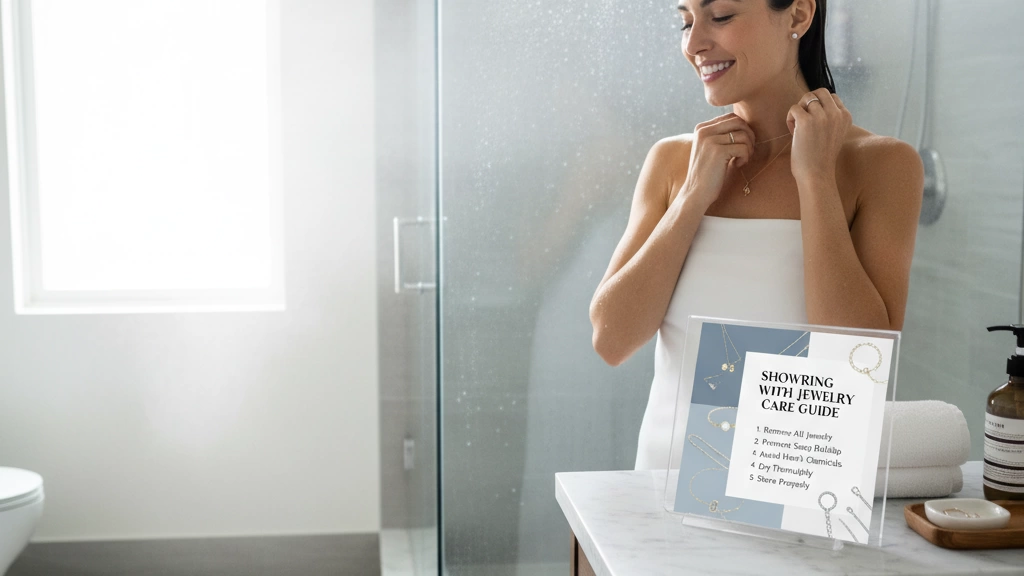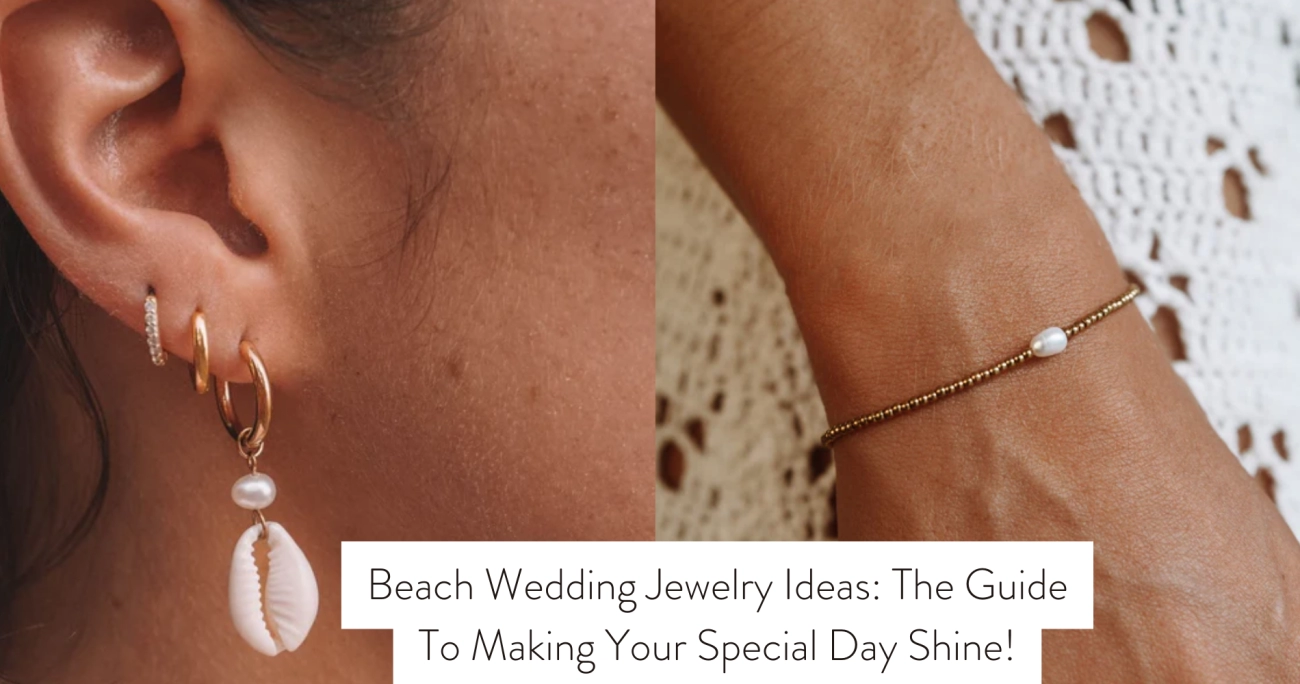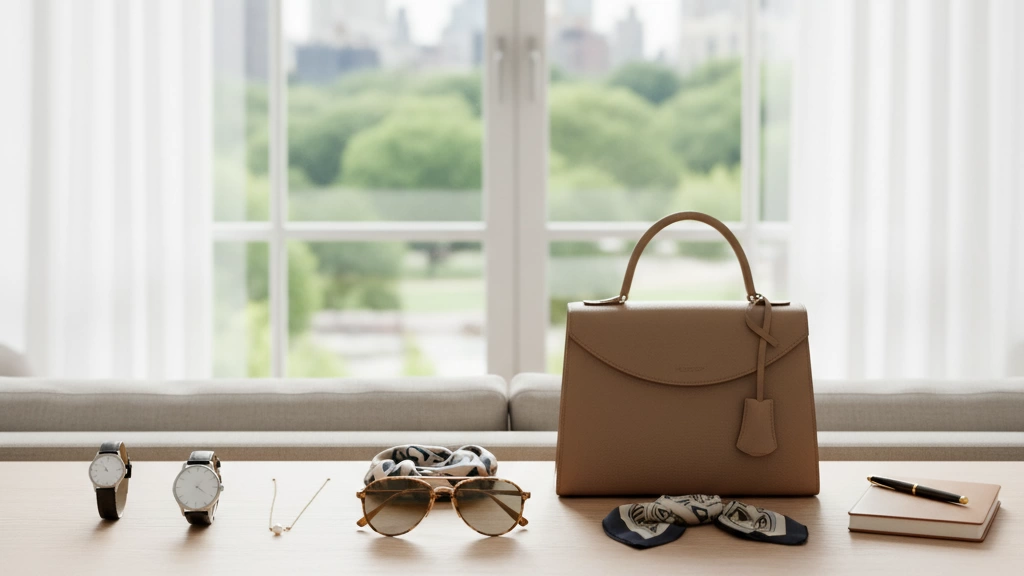If you’ve ever wondered, “Can I shower with my jewelry on?”, you’re not alone. It’s one of those everyday questions that sounds simple but actually hides a lot of confusion — because not all jewelry plays by the same rules. From your favorite gold ring to that delicate pearl necklace, some pieces can take the steamy heat and soap, while others will quietly tarnish or even fall apart. In this guide, we’re cutting through the guesswork with clear do’s and don’ts of showering with your jewelry — so you know exactly which metals, gemstones, and styles are safe for your daily rinse, and which ones you should always stash away. Let’s get right to it and save your sparkle!
Why Showering Can Damage Your Jewelry
Showering may seem harmless, but it can actually cause serious wear and tear on your jewelry. Here’s why:
-
Heat expands metal and loosens settings: Warm water causes metals to expand slightly, which can loosen prongs or settings holding your stones. Over time, this increases the risk of stones falling out.
-
Soap film buildup and residue: Shampoo, conditioner, and body wash leave behind a slippery film on your jewelry. This dulls metal shine and can trap dirt or bacteria in tiny crevices.
-
Hard water minerals & chlorine attack: Minerals like calcium and magnesium in hard water create deposits that dull metal and stones. Meanwhile, chlorine (especially in tap water or pools) aggressively wears down metals and damages delicate gemstones.
-
pH of shampoos and conditioners affecting metals: Many hair products have acidic or alkaline formulas that react with metals, causing tarnishing or corrosion, especially on softer or plated jewelry.
Understanding these factors helps explain why even daily showering with jewelry can lead to premature damage or tarnish. Next, we’ll cover what jewelry can safely stay on—and what to always remove before hopping in the shower!
The Definitive “Do’s” – Jewelry That’s Usually Safe to Shower With
Not all jewelry has to come off before you hop in the shower. Here’s what you can usually keep on without worry:
-
Solid 14k–18k gold (yellow, white, rose): Plain bands or those with minimal, secure settings generally hold up well. Higher karat gold is less reactive to water and shower products.
-
Pure platinum jewelry: Platinum is dense and resistant to corrosion, making it one of the best metals for shower-safe jewelry.
-
High-quality titanium and surgical stainless steel: These durable metals, commonly used in wedding bands and medical IDs, resist rust and tarnish even in wet conditions.
-
Silicone or rubber wedding rings: Perfect for active lifestyles or shower time, these flexible rings won’t get damaged or lose their shape.
-
Diamonds in bezel or strong prong settings: Diamonds themselves are very hard, but only wear them in the shower if the settings are sturdy enough. Loose prongs or glued stones warrant caution.
-
Lab-grown diamonds: Treat these just like natural diamonds—they’re equally durable but still need secure settings.
-
Waterproof-rated luxury watches: Watches with water resistance of 100m or more are built to handle showers, pools, and even swimming sessions without issue.
Choosing the right jewelry for daily wear, especially when it involves water exposure, can save you from damage and frequent repairs. If you want to learn more about pairing your everyday jewelry to fit your lifestyle, check out our guide on jewelry pairing rules you should know and when to break them.
The Hard “Don’ts” – Never Shower with These
Some jewelry materials just don’t play well with water, soap, or the heat of a shower. Here’s what you should always take off before you step in:
- Sterling silver (925): It tarnishes quickly when exposed to moisture and soap residue, turning black faster than you’d like.
- Gold-filled, gold-plated, or vermeil jewelry: The thin outer layers wear off with water and soap, revealing the base metal underneath.
- Costume or fashion jewelry: Usually made with base metals that tarnish or corrode easily in the shower.
- Porous or soft stones like opals, emeralds, pearls, turquoise, malachite, lapis, and amber: These gems absorb water and chemicals, causing damage, discoloration, or brittleness.
- Colored gemstones like tanzanite, fluorite, and kunzite: Most aren’t water-safe and can lose their lustre or crack.
- Antique or heirloom pieces: Older construction often involves glued stones or delicate settings that water and heat can weaken.
- Jewelry with glued-in stones or pavé settings: Glue breaks down with moisture, risking stone loss.
- Leather, wood, or fabric elements: Water soaks right in, causing warping and deterioration.
- Rose gold with heavy copper alloy: Copper reacts more in water and can develop greenish discoloration over time.
If your jewelry falls into any of these groups, it’s best to remove it before showering to keep it looking great longer.
For more on selecting jewelry materials that suit your lifestyle, check out this modern guide to mixing metals.
Material-by-Material Breakdown (Quick Reference Table)
| Material | Safe to Shower With? | Notes |
|---|---|---|
| Solid 14k–18k Gold | Usually yes | Plain bands or minimal settings; avoid heavy plating |
| Platinum | Yes | Highly water-resistant and durable |
| Titanium & Stainless Steel | Yes | Great for everyday wear; ideal for wedding bands & IDs |
| Silicone or Rubber Rings | Yes | Perfect for shower, gym, and beach |
| Diamonds (Bezel or Strong Prongs) | Usually yes | Avoid loose settings; watch for soap residue buildup |
| Lab-Grown Diamonds | Same rules as natural diamonds | Durable but check setting security |
| Waterproof Watches (100m+) | Yes | Designed to handle showers and swimming |
| Sterling Silver (925) | No | Tarnishes quickly from water and soap residue |
| Gold-Plated/Gold-Filled | No | Coating wears off with water exposure |
| Costume/Fashion Jewelry | No | Base metals corrode and discolor |
| Opals, Pearls, Turquoise, Amber | No | Porous and soft — water damages them |
| Tanzanite, Kunzite, Fluorite | No | Colored stones are often sensitive to water and chemicals |
| Antique or Heirloom | No | Fragile settings and materials |
| Jewelry with glued stones or pavé | No | Water can weaken the glue causing stones to fall out |
| Leather, Wood, Fabric | No | Water ruins these materials |
| Rose Gold (heavy copper alloy) | Avoid | Copper reacts more with water and soap chemicals |
Keep this table handy for quick decisions on what jewelry pieces to keep on or remove before showering. For example, if you’re unsure about whether to shower with your engagement ring or everyday gold hoops, knowing the material and setting can help you avoid damage. For tips on matching earrings and other pieces for daily wear, you might find advice on how to match your earrings with your neckline useful.
Special Cases People Always Ask About
Can I shower with my engagement ring?
Most engagement rings, especially those with solid gold or platinum bands and diamonds set in secure bezel or prong settings, are generally safe for showering. However, constant exposure to soap residue, shampoo, and heat can dull their shine and loosen stones over time. It’s best to remove your ring for showers when possible to avoid buildup and keep it sparkling longer.
What about everyday gold hoop earrings?
If your gold hoops are solid 14k or higher, they usually hold up well to showering. Just watch out for earrings with glued stones or delicate settings, as water and soap can weaken adhesives. Daily wear jewelry care means occasional cleaning to remove soap film and prevent tarnish, especially with white gold or rose gold variations.
Cartier Love bracelet – yes or no?
The iconic Cartier Love bracelet is crafted from solid gold or platinum, making it quite resistant to water and soap. You can technically shower with it, but frequent exposure to chlorine and soaps isn’t ideal for maintaining its finish. For the best care, take it off before showering and save it for dry occasions.
Apple Watch / Fitbit / smart jewelry
Many smartwatches like Apple Watch and Fitbit models come with water resistance ratings suitable for showering, but manufacturers often advise caution with hot water and soaps that can degrade seals and bands. Always check your specific device’s water resistance guide before showering with it.
Tattoos & new piercings with jewelry
Avoid showering with jewelry in new piercings or fresh tattoos because soap and water can cause irritation or infection. Stick to cleaning with recommended rinses and wait for full healing before wearing any jewelry in these areas during showers.
For more on everyday wear and stylish pieces, check out our top 5 jewelry trends for this season and why dainty jewelry continues to dominate the fashion world.
How to Build a 30-Second Shower-Proof Jewelry Routine
Keeping your jewelry safe from water damage doesn’t have to be complicated. Here’s a quick routine you can follow every time you shower:
-
Keep a small dish or tray by the shower or sink. This gives you a dedicated spot to “park” your rings, earrings, or bracelets before you hop in. Magnetic trays or ring holders work great for keeping everything secure and in one place.
-
Switch to silicone or rubber rings for daily showering, gym, or beach wear. These materials are water-resistant and won’t react to chlorine, soap residue, or hard water minerals, making them perfect for active lifestyles.
-
Choose when you wear your jewelry: morning or night. If you like wearing your pieces all day, make a habit of removing them before your shower. Alternatively, if you’re a morning jewelry wearer, put your pieces on after you’re done showering to prevent unnecessary exposure. This small shift helps reduce buildup from soaps and shampoos.
Building these habits into your routine takes less than 30 seconds and can save you from costly repairs or cleaning down the line. For more on choosing everyday jewelry and caring for different types of metals, check out this guide on understanding different types of metal in jewelry making.
What to Do If You Accidentally Showered with Jewelry

If you realize you’ve showered with your jewelry, don’t panic. Acting quickly can save your pieces from lasting damage.
Immediate gentle cleaning steps:
- Rinse your jewelry under lukewarm water to wash away soap residue.
- Use a soft toothbrush with mild dish soap to gently scrub away grime and film buildup.
- Avoid harsh chemicals or abrasive cloths that could scratch or damage delicate stones and metals.
How to remove soap scum and restore shine:
- Soak your pieces in a solution of warm water mixed with a few drops of mild dish soap for 15–20 minutes.
- For stubborn soap scum, a soft-bristled brush helps lift residue without harming the finish.
- Dry thoroughly with a soft microfiber cloth to avoid water spots or mineral deposits, especially if you have hard water.
When to take it to a jeweler:
- If your jewelry still looks dull or tarnished after cleaning, professional polishing may be needed.
- Any loose stones, bent prongs, or visible metal damage should be checked immediately by a jeweler.
- For pieces with glued-in stones or antique items, it’s safer to get expert advice instead of DIY cleaning.
Building a quick post-shower routine like this helps prevent buildup from soap, chlorine, or minerals — key to keeping your favorite pieces looking their best every day.
For tips on how to keep your jewelry organized and safe when not wearing it, check out this simple guide to storing your necklaces and bracelets.
Pro Tips to Make Jewelry Last Longer (Even If You Never Shower With It)
To keep your jewelry looking great over time, even if you never shower with it, here are some easy but effective tips:
-
Store Properly: Keep your pieces in a soft pouch or lined jewelry box to avoid scratches and tangles. Separate metals and gemstones to prevent damage.
-
Regular Polishing: Use a gentle polishing cloth to restore shine and remove fingerprints or light tarnish. Avoid harsh chemicals that can wear down delicate surfaces.
-
Professional Cleaning: Schedule a professional cleaning and inspection at least once a year. This helps catch loose settings and keeps metals bright.
-
Maintain White Gold with Rhodium Plating: White gold often has a rhodium layer for shine. This plating will wear over time, so re-plating every couple of years keeps it looking like new.
-
Insurance and Appraisals: Keep your jewelry insured and update appraisals regularly. This protects your investment against loss, theft, or damage.
Following these steps ensures your jewelry lasts and shines, no matter how often you wear it—or shower with it.
For more on daily care and jewelry protection, check out this detailed guide on jewelry maintenance and care.


